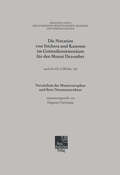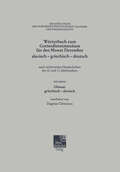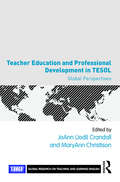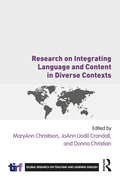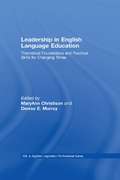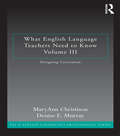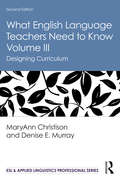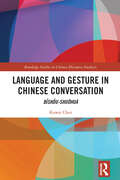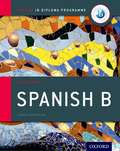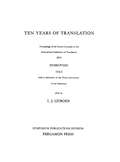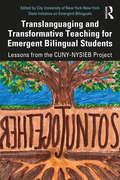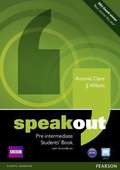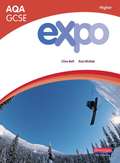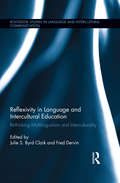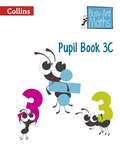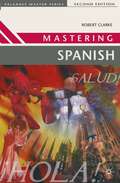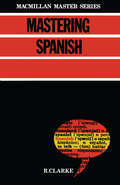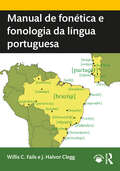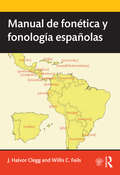- Table View
- List View
Die Notation von Stichera und Kanones im Gottesdienstmenäum für den Monat Dezember: nach der Hs. GIM Sin. 162; Verzeichnis der Musterstrophen und ihrer Neumenstruktur (Abhandlungen der Nordrhein-Westfälischen Akademie der Wissenschaften #108)
by Dagmar ChristiansWörterbuch zum Gottesdienstmenäum für den Monat Dezember slavisch - griechisch - deutsch: nach ostslavischen Handschriften des 12. und 13. Jahrhunderts (Abhandlungen der Rheinisch-Westfälischen Akademie der Wissenschaften #8)
by Dagmar ChristiansTeacher Education and Professional Development in TESOL: Global Perspectives (Global Research on Teaching and Learning English)
by JoAnn Jodi Crandall And MaryAnn ChristisonAt the forefront of research on English language teacher education and professional development, this volume presents new empirical research situated in different contexts around the world, including Canada, Denmark, Israel, Japan, Korea, Qatar, Sudan, and the U.S. It is framed by the volume editors’ insightful overview and analyses of previous and ongoing work in a variety of related domains and an epilogue by David Nunan. The chapter studies are organized around three themes: teacher identity in ESL/EFL teacher education and professional development programs, second language teacher education programs for diverse contexts, and professional development for diverse contexts. All chapters focus on the applied nature of the research and include a section on implications. To provide balance and a range of views, the volume includes both chapters reporting on empirical research funded by TIRF grant recipients and several from invited authors who are senior scholars in the field. This is the third volume in the Global Research on Teaching and Learning English Series, co-published by Routledge and TIRF.
Research on Integrating Language and Content in Diverse Contexts (Global Research on Teaching and Learning English)
by MaryAnn Christison JoAnn Jodi Crandall Donna ChristianCo-published with The International Research Foundation for English Language Education (TIRF), the ninth volume in the Global Research on Teaching and Learning English series presents research on the practice of integrating content and language in diverse contexts where English is used as a medium of instruction. With chapters written by TIRF Doctoral Dissertation Grant awardees and other scholars, the volume offers an overview of a wide range of methodological approaches to teaching content in English to English learners and examines factors that impede or contribute to effective instruction. The chapters include findings from original empirical research, as well as overviews of existing research and model programs, providing valuable insights and taking into account a multitude of contextual features. Offering up-to-date research on integrating language and content at the primary, secondary, and postsecondary levels, this book familiarizes readers with the latest advances in theory and practice. It is a key text for teacher education courses for preservice teachers, a resource for professional development programs for practicing teachers, and a useful reference for researchers.
Research on Integrating Language and Content in Diverse Contexts (Global Research on Teaching and Learning English)
by MaryAnn Christison JoAnn Jodi Crandall Donna ChristianCo-published with The International Research Foundation for English Language Education (TIRF), the ninth volume in the Global Research on Teaching and Learning English series presents research on the practice of integrating content and language in diverse contexts where English is used as a medium of instruction. With chapters written by TIRF Doctoral Dissertation Grant awardees and other scholars, the volume offers an overview of a wide range of methodological approaches to teaching content in English to English learners and examines factors that impede or contribute to effective instruction. The chapters include findings from original empirical research, as well as overviews of existing research and model programs, providing valuable insights and taking into account a multitude of contextual features. Offering up-to-date research on integrating language and content at the primary, secondary, and postsecondary levels, this book familiarizes readers with the latest advances in theory and practice. It is a key text for teacher education courses for preservice teachers, a resource for professional development programs for practicing teachers, and a useful reference for researchers.
Leadership in English Language Education: Theoretical Foundations and Practical Skills for Changing Times
by MaryAnn Christison Denise E. MurrayLeadership in English Language Education: Theoretical Foundations and Practical Skills for Changing Times presents both theoretical approaches to leadership and practical skills leaders in English language education need to be effective. Discussing practical skills in detail, and providing readers with the opportunity to acquire new skills and apply them in their own contexts, the text is organized around three themes: The roles and characteristics of leaders Skills for leading ELT leadership in practice Leadership theories and approaches from business and industry are applied to and conclusions are drawn for English language teaching in a variety of organizational contexts, including intensive English programs in English-speaking countries, TESOL departments in universities, ESL programs in community colleges, EFL departments in non-English speaking countries, adult education programs, and commercial ELT centers and schools around the world. This is an essential resource for all administrators, teachers, academics, and teacher candidates in English language education.
Leadership in English Language Education: Theoretical Foundations and Practical Skills for Changing Times
by MaryAnn Christison Denise E. MurrayLeadership in English Language Education: Theoretical Foundations and Practical Skills for Changing Times presents both theoretical approaches to leadership and practical skills leaders in English language education need to be effective. Discussing practical skills in detail, and providing readers with the opportunity to acquire new skills and apply them in their own contexts, the text is organized around three themes: The roles and characteristics of leaders Skills for leading ELT leadership in practice Leadership theories and approaches from business and industry are applied to and conclusions are drawn for English language teaching in a variety of organizational contexts, including intensive English programs in English-speaking countries, TESOL departments in universities, ESL programs in community colleges, EFL departments in non-English speaking countries, adult education programs, and commercial ELT centers and schools around the world. This is an essential resource for all administrators, teachers, academics, and teacher candidates in English language education.
What English Language Teachers Need to Know Volume III: Designing Curriculum
by MaryAnn Christison Denise E. MurrayWhat English Teachers Need to Know, a set of companion texts designed for pre-service teachers and teachers new to the field of ELT, addresses the key question: What do English language teachers need to know and be able to do in order for their students to learn English? These texts work for teachers across different contexts (countries where English is the dominant language, one of the official languages, or taught as a foreign language); different levels (elementary/primary, secondary, college or university, or adult education); and different learning purposes (general English, workplace English, English for academic purposes, or English for specific purposes). Volume I, on understanding learning, provides the background information that teachers need to know and be able to use in their classroom. Volume II, on facilitating learning, covers the three main facets of teaching: planning, instructing, and assessing. Volume III, on designing curriculum, covers the contexts for, processes in, and types of ELT curricula—linguistic based, content-based, learner-centered, and learning-centered. Throughout the three volumes, the focus is on outcomes, that is, student learning. Features • Situated in current research in the field of English language teaching and other disciplines that inform it • Sample data, including classroom vignettes • Three kinds of activities/tasks: Reflect, Explore, and Expand
What English Language Teachers Need to Know Volume III: Designing Curriculum
by MaryAnn Christison Denise E. MurrayWhat English Teachers Need to Know, a set of companion texts designed for pre-service teachers and teachers new to the field of ELT, addresses the key question: What do English language teachers need to know and be able to do in order for their students to learn English? These texts work for teachers across different contexts (countries where English is the dominant language, one of the official languages, or taught as a foreign language); different levels (elementary/primary, secondary, college or university, or adult education); and different learning purposes (general English, workplace English, English for academic purposes, or English for specific purposes). Volume I, on understanding learning, provides the background information that teachers need to know and be able to use in their classroom. Volume II, on facilitating learning, covers the three main facets of teaching: planning, instructing, and assessing. Volume III, on designing curriculum, covers the contexts for, processes in, and types of ELT curricula—linguistic based, content-based, learner-centered, and learning-centered. Throughout the three volumes, the focus is on outcomes, that is, student learning. Features • Situated in current research in the field of English language teaching and other disciplines that inform it • Sample data, including classroom vignettes • Three kinds of activities/tasks: Reflect, Explore, and Expand
What English Language Teachers Need to Know Volume III: Designing Curriculum (ESL & Applied Linguistics Professional Series)
by MaryAnn Christison Denise E. MurrayDesigned for pre-service and novice teachers in ELT, What English Language Teachers Need to Know Volumes I, II, and III are companion textbooks organized around the key question: What do teachers need to know and be able to do in order to help their students to learn English?Thoroughly revised and updated, the second edition of Volume III explores the contexts for ELT curricula; explains key processes in curriculum design; and sets out approaches to curricula that are linguistic-based, content-based, learner centered, and learning centered. Organized around the three pillars of teaching—planning, instructing, and assessing—chapters in the second edition are updated to include current research and theory to meet the needs of today’s teachers, and feature new or revised vignettes and activities. New chapters help teachers understand both the technological and multilingual approaches that learners need to succeed today. The comprehensive texts of this series are suitable resources for teachers across different contexts—where English is the dominant language, an official language, or a foreign language; for different levels—elementary/primary, secondary, university, or adult education; and for different learning purposes—general English, workplace English, English for academic purposes, or English for specific purposes.
What English Language Teachers Need to Know Volume III: Designing Curriculum (ESL & Applied Linguistics Professional Series)
by MaryAnn Christison Denise E. MurrayDesigned for pre-service and novice teachers in ELT, What English Language Teachers Need to Know Volumes I, II, and III are companion textbooks organized around the key question: What do teachers need to know and be able to do in order to help their students to learn English?Thoroughly revised and updated, the second edition of Volume III explores the contexts for ELT curricula; explains key processes in curriculum design; and sets out approaches to curricula that are linguistic-based, content-based, learner centered, and learning centered. Organized around the three pillars of teaching—planning, instructing, and assessing—chapters in the second edition are updated to include current research and theory to meet the needs of today’s teachers, and feature new or revised vignettes and activities. New chapters help teachers understand both the technological and multilingual approaches that learners need to succeed today. The comprehensive texts of this series are suitable resources for teachers across different contexts—where English is the dominant language, an official language, or a foreign language; for different levels—elementary/primary, secondary, university, or adult education; and for different learning purposes—general English, workplace English, English for academic purposes, or English for specific purposes.
Language and Gesture in Chinese Conversation: Bǐshǒu-shuōhuà (Routledge Studies in Chinese Discourse Analysis)
by Kawai ChuiLanguage and Gesture in Chinese Conversation is a study of the semantic and temporal relationships between the speech and the gesture in the context of discourse interaction in Mandarin Chinese spoken in Taiwan. The cross-modal representation of ideas in natural discourse reveals the nature of BĬSHŎU-SHUŌHUÀ in the communication of meaning. The study addresses two central issues: • How do language and gesture represent the semantic information of various types of ideas? • How do the linguistic representation and gestural depiction pattern temporally in the communication of cross-modal information? The intended audience of this book are scholars in many academic fields, including linguistics, language and gesture, human communication, cognition, cognitive neuroscience, social psychology, sociology, linguistic anthropology, speech pathology, and speech therapy.
Language and Gesture in Chinese Conversation: Bǐshǒu-shuōhuà (Routledge Studies in Chinese Discourse Analysis)
by Kawai ChuiLanguage and Gesture in Chinese Conversation is a study of the semantic and temporal relationships between the speech and the gesture in the context of discourse interaction in Mandarin Chinese spoken in Taiwan. The cross-modal representation of ideas in natural discourse reveals the nature of BĬSHŎU-SHUŌHUÀ in the communication of meaning. The study addresses two central issues: • How do language and gesture represent the semantic information of various types of ideas? • How do the linguistic representation and gestural depiction pattern temporally in the communication of cross-modal information? The intended audience of this book are scholars in many academic fields, including linguistics, language and gesture, human communication, cognition, cognitive neuroscience, social psychology, sociology, linguistic anthropology, speech pathology, and speech therapy.
Spanish B: Course Companion (Second Edition) (PDF) (IB Diploma Program Ser.)
by Laura Cisneros Ana ValbuenaFully addressing all aspects of the 2018 syllabus at SL and HL, this rich and challenging course book pack drives confidence and achievement in Spanish B.
Ten Years of Translation: Proceedings of the Fourth Congress of the International Federation of Translators (FIT), Dubrovnik, 1963, Held in Celebration of the Tenth Anniversary of the Federation
by I. J. CitroenTen Years of Translation documents the proceedings of the Fourth Congress of the International Federation of Translators (Fédération Internationale des Traducteurs—FIT) held in Dubrovnik in 1963. This compilation discusses the diversification and development of the translating profession that focuses on the types of translation practiced, great variety of circumstances under which the translation is carried out, and vast number of auxiliary services and aids closely related to the translation proper. This book includes the descriptions of literary, technical, and scientific translations; linguistic aspects of translation; FIT committee reports; progress reports by FIT member societies; and charter of the translator. This publication is beneficial to professional translators, as well as students and researchers conducting work on linguistics.
Translanguaging and Transformative Teaching for Emergent Bilingual Students: Lessons from the CUNY-NYSIEB Project
by City University City University of New York-New York State Initiative on Emergent BilingualsA critical and accessible text, this book provides a foundation for translanguaging theory and practice with educating emergent bilingual students. The product of the internationally renowned and trailblazing City University of New York-New York State Initiative on Emergent Bilinguals (CUNY-NYSIEB), this book draws on a common vision of translanguaging to present different perspectives of its practice and outcomes in real schools. It tells the story of the collaborative project’s positive impact on instruction and assessment in different contexts, and explores the potential for transformation in teacher education. Acknowledging oppressive traditions and obstacles facing language minoritized students, this book provides a pathway for combatting racism, monolingualism, classism and colonialism in the classroom and offers narratives, strategies and pedagogical practices to liberate and engage emergent bilingual students. This book is an essential text for all teacher educators, researchers, scholars, and students in TESOL and bilingual education, as well as educators working with language minoritized students.
Speakout Pre-intermediate Students Book: With Active Book
by Antonia Clare J J Wilson'Speakout' is a 6-level general English course for adults developed in association with the BBC; bridging the gap between the classroom and the real world helping students express themselves in English.
Aqa Gcse Expo
by John Clare Clive Bell Rosi Mcnab'Expo' provides total support for the AQA specification with motivating resources and a strong focus on controlled assessment and exam preparation from day one.
Reflexivity in Language and Intercultural Education: Rethinking Multilingualism and Interculturality (Routledge Studies in Language and Intercultural Communication)
by Julie S. Byrd Clark Fred DervinWith the impact of accelerated globalization, digital technologies, mobility, and migration, the fields of Applied Linguistics, Language, and Intercultural Education have been shifting. One shift in need of further exploration is that of systematic and coherent reflexivity in researching language and culture. This unique and timely book thus examines the significance of reflexivity as an integral process, particularly when researching the multifaceted notions of multilingualism and interculturality in education. It also contributes to current critical approaches to representations of languages and cultures in identity politics. As such, the authors offer innovative ways of engaging with reflexivity in teaching, learning, and research through multimodal and complex ways. The chapters span a diverse range of educational settings in Asia, Australia, Europe, and North America.
Busy Ant Maths European edition — PUPIL BOOK 3C: (PDF)
by Peter ClarkeThe Busy Ant Maths Pupil Book 3C contains three levels of differentiated challenge built-in to each lesson as well as extra consolidation and extension activities to ensure rapid progression for every child.
Mastering Spanish (Macmillan Master Series)
by Robert ClarkeMastering Spanish has long been a popular and respected course, teaching everyday language with a thorough grammatical underpinning. There are many varied and practical exercises and a puzzles section. The course offers full, user-friendly explanations to all language points making it ideal for adults returning to language learning.Two cassettes are available separately (ISBN 9780333614372) and include additional unscripted dialogues with exercises to attune students' ears to the real sound of the language.
Manual de fonética e fonologia da língua portuguesa
by J. Halvor Clegg Willis C. FailsEscrito inteiramente em português, o Manual de fonética e fonologia da língua portuguesa é uma obra que abrange todos os aspectos fonéticos e fonológicos desse idioma, inclusive as questões de fonética acústica e auditiva, fonotática e traços suprassegmentais, que a maioria dos livros didáticos não aborda. Neste livro, o estudante encontrará uma introdução detalhada e exata, mas acessível, à fonética e à fonologia da língua portuguesa. Inclui capítulos introdutórios que contextualizam essas disciplinas no campo geral da linguística e salientam o papel dos sons e sua representação na comunicação humana. Principais características: ● Escrito por fonetistas qualificados e versados nas questões atuais da ciência fonética. ● Não é preciso já saber linguística, pois o livro expõe todos os termos e conceitos linguísticos necessários. ● Cada capítulo conta com um resumo, uma lista de conceitos e termos, perguntas de revisão e exercícios de pronúncia relevantes destinados à prática dos conselhos e sugestões específicos do capítulo. ● Os capítulos que abordam a produção física dos sons contêm seções de "Dicas Pedagógicas", "Conselhos Práticos" e "Exercícios de Pronúncia" que ligam a teoria aos aspectos práticos da boa pronúncia. ● Uma característica exclusiva deste livro é a exposição da fonética e fonologia das três principais normas cultas da língua portuguesa: a de São Paulo e do Rio de Janeiro para o português brasileiro (PB), e a de Lisboa para o português europeu (PE). ● Numerosas imagens, gráficos e tabelas para ilustrar claramente cada conceito. ● Recursos eletrônicos, disponíveis online nos materiais de eResource, com a pronúncia dos sons, frases e exercícios do livro. O Manual de fonética e fonologia da língua portuguesa é uma introdução abrangente a esses campos, escrita de modo a ser clara e acessível aos estudantes de português em nível avançado, para ajudá-los a entender como melhorar a própria pronúncia. O livro é excelente também tanto para alunos de pós-graduação, como para professores, linguistas e profissionais de letras. Written entirely in Portuguese, Manual de fonética e fonologia da língua portuguesa presents an accurate yet accessible introduction to Portuguese phonetics and phonology. The book covers all phonetic and phonological aspects of the language, including those often missing from other textbooks, such as acoustic and auditory phonetics, phonotactics, and suprasegmentals. The book maintains a careful balance between the theoretical and practical aspects of the topic and is designed to help learners improve their pronunciation through an understanding of the linguistic principles of phonetics and phonology combined with the application of these principles through exercises and practice. Additional pronunciation resources are available online at www.routledge.com/9780367179915. Written in a clear and accessible manner, the book is ideal for advanced students of Portuguese with no prior knowledge of linguistics.
Manual de fonética y fonología españolas
by J. Halvor Clegg Willis C. FailsWritten entirely in Spanish, Manual de fonética y fonología españolas has a comprehensive scope that touches on all aspects of phonetics and phonology—including acoustic and auditory phonetics, phonotactics, and suprasegmentals, which most often remain untreated. The book provides students with a detailed and accurate yet accessible introduction to Spanish phonetics and phonology. It includes introductory chapters which place these disciplines within the general field of linguistics and which emphasize the role of sounds and their representation in human communication. Key features: Written by trained phoneticians and informed by the current science of phonetics. No prior knowledge of linguistics assumed, as a foundation is laid throughout for all linguistic terms and concepts. Each chapter contains a summary, a list of concepts and terminology, review questions, and pedagogically relevant pronunciation exercises keyed to the specific hints and suggestions provided in the chapters. Chapters dealing with the physical production of sounds contain sections with “Pedagogical Hints,” “Practical Suggestions,” and “Pronunciation Exercises” to link theory to the practical aspects of improving pronunciation. A wealth of graphic material to illustrate each concept clearly. Models of how to pronounce the sounds, sentences and exercises presented in the text, are available online at routledge.com/cw/clegg. Manual de fonética y fonología españolas is a comprehensive introduction designed to be clear and accessible to advanced students of Spanish to help them understand how to improve their pronunciation. It will serve as an excellent book for graduate students as well as a valuable resource for teachers, linguists and language professionals.
Manual de fonética y fonología españolas
by J. Halvor Clegg Willis C. FailsWritten entirely in Spanish, Manual de fonética y fonología españolas has a comprehensive scope that touches on all aspects of phonetics and phonology—including acoustic and auditory phonetics, phonotactics, and suprasegmentals, which most often remain untreated. The book provides students with a detailed and accurate yet accessible introduction to Spanish phonetics and phonology. It includes introductory chapters which place these disciplines within the general field of linguistics and which emphasize the role of sounds and their representation in human communication. Key features: Written by trained phoneticians and informed by the current science of phonetics. No prior knowledge of linguistics assumed, as a foundation is laid throughout for all linguistic terms and concepts. Each chapter contains a summary, a list of concepts and terminology, review questions, and pedagogically relevant pronunciation exercises keyed to the specific hints and suggestions provided in the chapters. Chapters dealing with the physical production of sounds contain sections with “Pedagogical Hints,” “Practical Suggestions,” and “Pronunciation Exercises” to link theory to the practical aspects of improving pronunciation. A wealth of graphic material to illustrate each concept clearly. Models of how to pronounce the sounds, sentences and exercises presented in the text, are available online at routledge.com/cw/clegg. Manual de fonética y fonología españolas is a comprehensive introduction designed to be clear and accessible to advanced students of Spanish to help them understand how to improve their pronunciation. It will serve as an excellent book for graduate students as well as a valuable resource for teachers, linguists and language professionals.
